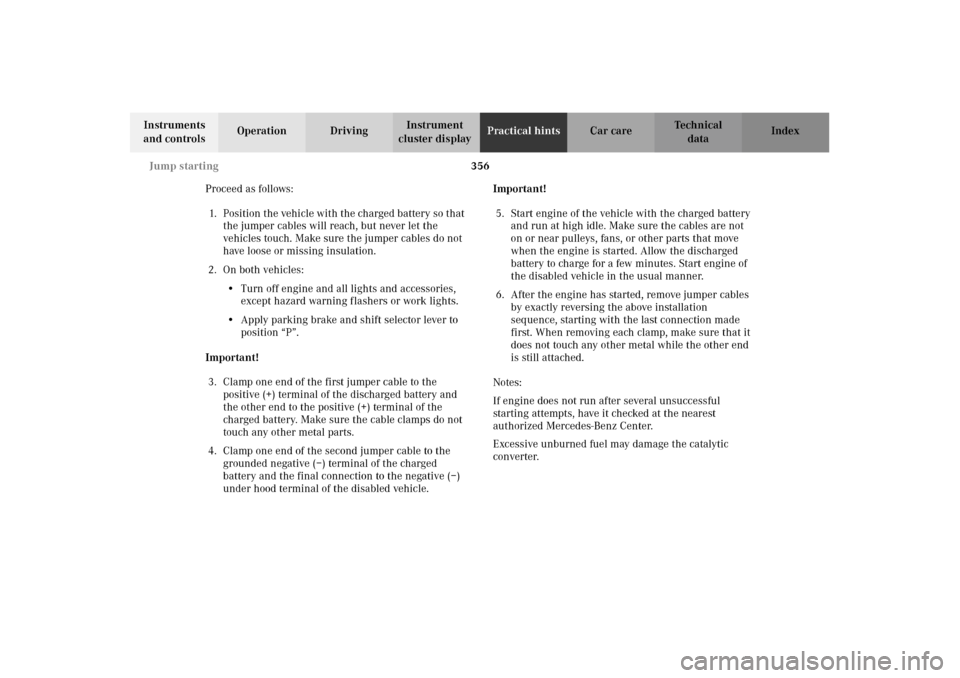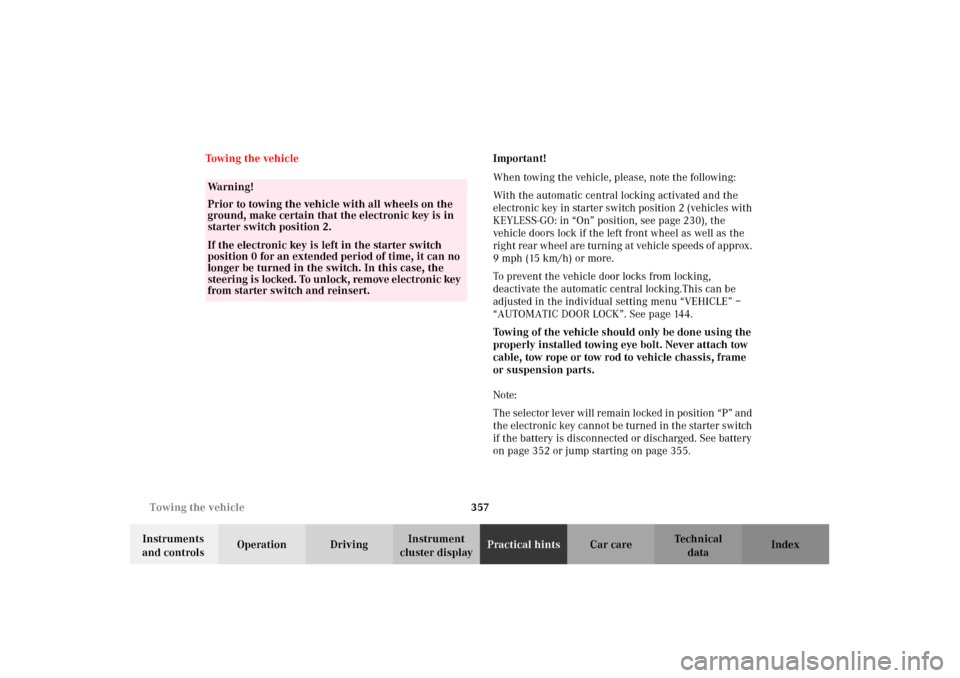Page 359 of 430

356 Jump starting
Te ch n i c a l
data Instruments
and controlsOperation DrivingInstrument
cluster displayPractical hintsCar care Index
Proceed as follows:
1. Position the vehicle with the charged battery so that
the jumper cables will reach, but never let the
vehicles touch. Make sure the jumper cables do not
have loose or missing insulation.
2. On both vehicles:
•Turn off engine and all lights and accessories,
except hazard warning flashers or work lights.
•Apply parking brake and shift selector lever to
position “P”.
Important!
3. Clamp one end of the first jumper cable to the
positive (+) terminal of the discharged battery and
the other end to the positive (+) terminal of the
charged battery. Make sure the cable clamps do not
touch any other metal parts.
4. Clamp one end of the second jumper cable to the
grounded negative (–) terminal of the charged
battery and the final connection to the negative (–)
under hood terminal of the disabled vehicle.Important!
5. Start engine of the vehicle with the charged battery
and run at high idle. Make sure the cables are not
on or near pulleys, fans, or other parts that move
when the engine is started. Allow the discharged
battery to charge for a few minutes. Start engine of
the disabled vehicle in the usual manner.
6. After the engine has started, remove jumper cables
by exactly reversing the above installation
sequence, starting with the last connection made
first. When removing each clamp, make sure that it
does not touch any other metal while the other end
is still attached.
Notes:
If engine does not run after several unsuccessful
starting attempts, have it checked at the nearest
authorized Mercedes-Benz Center.
Excessive unburned fuel may damage the catalytic
converter.
J_OM_215.book Seite 356 Mittwoch, 30. Mai 2001 2:01 14
Page 360 of 430

357 Towing the vehicle
Te ch n i c a l
data Instruments
and controlsOperation DrivingInstrument
cluster displayPractical hintsCar care Index Towing the vehicleImportant!
When towing the vehicle, please, note the following:
With the automatic central locking activated and the
electronic key in starter switch position 2 (vehicles with
KEYLESS-GO: in “On” position, see page 230), the
vehicle doors lock if the left front wheel as well as the
right rear wheel are turning at vehicle speeds of approx.
9 mph (15 km/h) or more.
To prevent the vehicle door locks from locking,
deactivate the automatic central locking.This can be
adjusted in the individual setting menu “VEHICLE” –
“AUTOMATIC DOOR LOCK”. See page 144.
Towing of the vehicle should only be done using the
properly installed towing eye bolt. Never attach tow
cable, tow rope or tow rod to vehicle chassis, frame
or suspension parts.
Note:
The selector lever will remain locked in position “P” and
the electronic key cannot be turned in the starter switch
if the battery is disconnected or discharged. See battery
on page 352 or jump starting on page 355.
Wa r n i n g !
Prior to towing the vehicle with all wheels on the
ground, make certain that the electronic key is in
starter switch position 2.If the electronic key is left in the starter switch
position 0 for an extended period of time, it can no
longer be turned in the switch. In this case, the
steering is locked. To unlock, remove electronic key
from starter switch and reinsert.
J_OM_215.book Seite 357 Mittwoch, 30. Mai 2001 2:01 14
Page 372 of 430
369 Electronic key
Te ch n i c a l
data Instruments
and controlsOperation DrivingInstrument
cluster displayPractical hintsCar care Index Changing batteries in the electronic key
1Transmit buttons
2Lamp for battery check and function control
Checking batteries
If one of the transmit buttons (1) is pressed, the battery
check lamp (2) lights up briefly – indicating that the
batteries are in order.
Change batteries if the battery check lamp (2) does not
light up briefly.Changing batteries
Move locking tab (3) in direction of right arrow and
remove mechanical key (4, left arrow).
P80.20-2201-26
1
2
P80.35-2029-26
4
3
J_OM_215.book Seite 369 Mittwoch, 30. Mai 2001 2:01 14
Page 373 of 430
370 Electronic key
Te ch n i c a l
data Instruments
and controlsOperation DrivingInstrument
cluster displayPractical hintsCar care Index
Insert mechanical key (4) in side opening (5) to open
latch. Press briefly (do not use mechanical key as lever)
to release battery compartment.
Remove mechanical key from side opening.
Carefully remove battery compartment in direction of
arrow (6).Change batteries (7), inserting new ones under contact
spring (8) with plus (+) side facing up.
Return battery compartment into housing until locked
in place and slide mechanical key back into electronic
key.
P80.35-2025-26
5
4
6
P80.35-2027-26
78
J_OM_215.book Seite 370 Mittwoch, 30. Mai 2001 2:01 14
Page 374 of 430
371 Electronic key
Te ch n i c a l
data Instruments
and controlsOperation DrivingInstrument
cluster displayPractical hintsCar care Index Important!
Batteries contain materials that can harm the
environment if disposed of improperly. Recycling of
batteries is the preferred method of disposal. For
disposal, please follow manufacturer’s recommendation
on battery package.
Replacement Battery:
Lithium, type CR 2025 or equivalent.Synchronizing remote control
The remote control may have to be resynchronized, if
the vehicle cannot be locked or unlocked.
To synchronize insert electronic key in starter switch.
The remote control should once again be operational.
J_OM_215.book Seite 371 Mittwoch, 30. Mai 2001 2:01 14
Page 376 of 430
373 KEYLESS-GO-card
Te ch n i c a l
data Instruments
and controlsOperation DrivingInstrument
cluster displayPractical hintsCar care Index Changing batteries
Pry open cover (1) (e.g. by using a narrow blade screw
driver) and remove batteries.
Install new batteries as indicated by the “+” and “-”
markings in the KEYLESS-GO-card.Important!
Batteries contain materials that can harm the
environment if disposed of improperly. Recycling of
batteries is the preferred method of disposal. For
disposal, please follow manufacturer’s recommendation
on battery package.
Replacement batteries:
Lithium, type CR 2025 or equivalent.
J_OM_215.book Seite 373 Mittwoch, 30. Mai 2001 2:01 14
Page 377 of 430
374 Emergency engine shut-down
Te ch n i c a l
data Instruments
and controlsOperation DrivingInstrument
cluster displayPractical hintsCar care Index
Emergency engine shut-down
If the engine can no longer be stopped using the
electronic key or the start-/stop button (vehicles with
KEYLESS-GO), the engine can be turned off by
withdrawing two fuses.
For easy removal of fuses use the fuse extractor
(supplied with vehicle tool kit) to pull out the fuses
marked on the fuse chart as “ENGINE EMERGENCY
OFF”.
The fuse chart is also located in the vehicle tool kit,
seepage341.
For fuses see page 331.Fuel filler flap, manual release
Remove the battery cover (see page 352) and the trim
inside the trunk on the right-hand side. Pull the release
knob (arrow) and open the fuel filler flap.
J_OM_215.book Seite 374 Mittwoch, 30. Mai 2001 2:01 14
Page 411 of 430

408 Index
Te ch n i c a l
data Instruments
and controlsOperation DrivingInstrument
cluster displayPractical hints Car careIndex
Front center console
storage compartment ventilation ...................... 180
MAXCOOL .................................................................. 172
Rear window defroster ............................................. 181
Residual engine heat utilization ............................ 179
Special settings ......................................................... 174
Switching on and off ................................................ 180
Windows fogged on the inside ................................ 175
Windows fogged on the outside ...............................176
Automatic maximum cooling ....................................... 172
Automatic transmission ...............................................235
Emergency operation ...............................................243
Fluid level ...................................................................338
Program mode selector switch ............................... 242
Selector lever position ..............................................238
BBabySmart
TM airbag deactivation system ..................... 88
Self-test ......................................................................... 89
Backrest ............................................................................. 72
BAS (Brake assist system) ............................................ 275
Battery .............................................................................352
Battery recycling ....................................................... 354BATTERY/ALTERNATOR -
malfunction and warning messages ..................... 305
Block heater ................................................................... 253
BRAKE ASSIST -
malfunction and warning messages ..................... 306
Brake assist system (BAS) ........................................... 275
Brake fluid ........................................... 246, 298, 399, 401
BRAKE FLUID -
malfunction and warning messages ..................... 307
Brake pad wear .............................................................. 307
BRAKE PAD WEAR -
malfunction and warning messages ..................... 307
Brake warning lamp ..................................................... 298
Brake fluid low ......................................................... 298
Brakes ...................................................244, 246, 275, 279
Bulbs
See Replacing bulbs ................................................. 360
CCapacities
Fuels, coolants, lubricants etc. .............................. 399
Card, KEYLESS-GO ..........................................................28
Cargo tie-down hooks ................................................... 206
Catalytic converter ........................................................ 226
Center console .................................................................. 24
J_OM_215.book Seite 408 Mittwoch, 30. Mai 2001 2:01 14